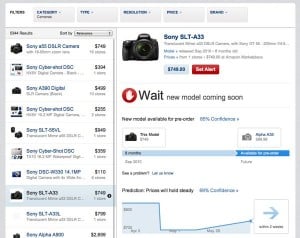
But now there’s a new online shopping service that claims to predict price drops—or hikes—for the latest digital cameras, HDTVs, and laptops, as well as warn you if the gadget you’ve been eyeing is about to become obsolete.
Decide.com launched just a few hours ago, and it’s kicking off with deals for digital cameras, TVs, and notebook PCs. (You can also vote on which new electronics categories you’d like the Decide.com team to add next.)
Search for the gadget you’re thinking of buying, click the listing, and you’ll get details such as the current low price, a line graph that charts the peaks and valleys in the product’s pricing history, and a prediction on whether the price tag will rise, fall, or stay put in the coming weeks.
The site will also make its best guess on whether a new model is on the way in the next few months, along with the bottom line on whether you should bide your time, or strike while the iron’s hot.
Example: I found a fancy Sony SLR-style digital camera (the SLT-A33) on Decide.com and learned that it’s a) about nine months old but b) just $749, a good $50 cheaper than the original $800 price tag.
Nice, but the Decide.com product page for the SLT-A33 has been stamped with a prominent “Wait.” Why? Because a newer model, the Alpha A35, is already available for pre-order for just $599.
So, what’s the secret behind Decide.com’s crystal ball? As the site’s official blog puts it:
…we are utilizing a proprietary 60-terabyte database comprised of model lineages (hundreds of thousands of devices mapped to their model lines), historical pricing (billions of price observations from thousands of sellers) and electronics rumors and news from across the web. On top of that, our data scientists apply advanced machine-learning and text-mining algorithms to predict future model releases and price changes.
Interesting—and potentially a handy way to avoid learning that the $1,500 HDTV you just bought is already yesterday’s news.
Source: CNET


Thanks for the 411. I wish I’d known about this before I bought my MacBook Pro in January, right before the announcements of the new one coming out that’s all fancyawesome.
I hear ya; I bought my current 27-inch iMac about two days before a spiffy new one was unveiled. Oh well.
Also, for anyone shopping for Mac products, check out MacRumors.com’s excellent buyer’s guide, complete with info and predictions on when new models are due:
http://buyersguide.macrumors.com/